Ruta de navegación
Menú de navegación
Blogs
The project 'One Belt-One Road' aims to consolidate China's rise as a superpower.
Xi Jinping's ambitious initiative to connect China to the rest of the Eurasian continent may prove costly and difficult. But unlike the overland route through the Central Asian republics, the sea route may not take long to become a reality on certain stretches, as China has already built some ports along part of the route.
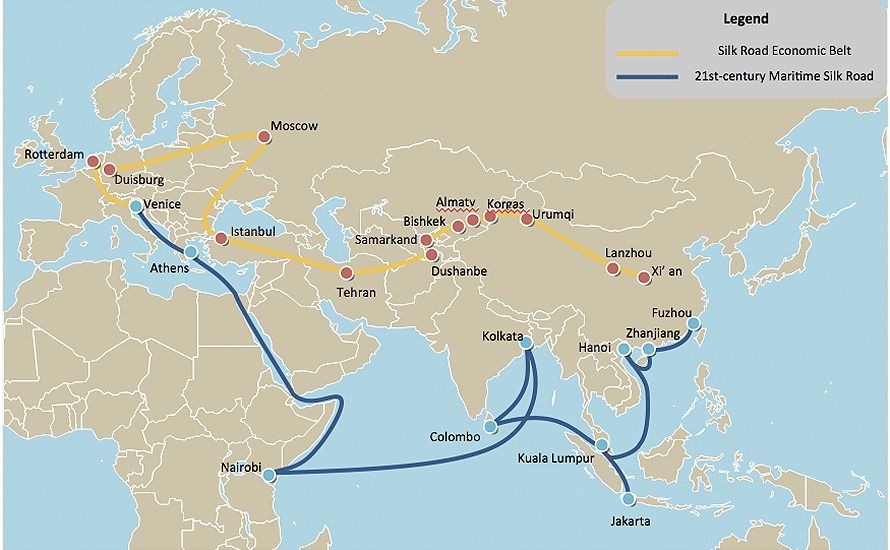
▲The land and sea routes of the Chinese initiative [yourfreetemplates].
article / Jimena Puga Gómez [English version].
Following Chinese President Xi Jinping's 2013 revitalisation of the ancient Silk Road speech , the initiative that started as an idea has become the Beijing government's biggest economic challenge: a revolution that, if realised, will change the Asian continent's passenger, freight and hydrocarbon transport infrastructure, as well as high-tech. Dubbed OBOR-OneBelt-One Road, the plan is intended to be the core topic of China's rise as a regional superpower.
The OBOR initiative is a grand plan to reshape China's strategic environment, project Beijing's economic power, secure the communist country's access to energy and mineral supplies, and boost economic growth in the west of the People's Republic. OBOR seeks to achieve these goals by fostering greater and faster connectivity between China and Europe through intermediate points in Central, West and South Asia, as well as with Russia.
For its part, the maritime route that will form one of the pieces core topic of the OBOR initiative, also known as the Silk Road of the 21st century, counts on the fact that seven of the ten largest ports in the world are in China and, as is well known, these infrastructures make the Asian giant an important exporter of port services management .
The Eastbound Maritime Silk Road will start in Fujian province and pass through Guangdong, Guangxi and Hainan, before heading south to the Strait of Malacca. From Kuala Lumpur, the Route will continue to Kolkata and Colombo, then cross the rest of the Indian Ocean towards Nairobi. From there, it will travel through the Horn of Africa, seeking to cross the strategic Gulf of Aden to the Red Sea. Beijing's plan aims to create sufficient infrastructure to allow Chinese ships to safely reach the Mediterranean after sailing through the Suez Canal. But the People's Republic's ambition does not stop at the EU's doorstep, as China wants to reach Athens via the Aegean and from there to Venice, where it will look for land routes to move its goods throughout the Union. Chinese investment has focused, among other things, on the port of Piraeus, with a new logistics centre, and on the development of a network of logistics infrastructures through the Balkans and Hungary.
The South Pacific has also been included in this strategic route map devised in Beijing. Thus, the maritime Silk Road has two routes. The first, as mentioned above, originates on China's east coast and, via the South China Sea, aims to establish strategic control of the Spratley Islands, the Strait of Malacca and the entire Indo-Pacific area, including the Bay of Bengal, in order to reach the heart of Europe. The second sea route will also cross the South China Sea to direct its ships to the coastal ports of the South Pacific. In this way, China would also control the routes for the essential raw materials that come from Latin America.
Although this is a long-term economic project deadline , the Chinese government has already begun the construction of certain infrastructures and the necessary negotiations with different countries. A clear example is Germany. The European Union is China's largest trading partner , while the People's Republic of China is the EU's second largest provider . sample . Germany is a country that not only enjoys an excellent reputation as a reliable partner in China, but is also regarded as "Europe's trade gateway". test This is why, at a meeting in Duisburg, the world's largest inland port and an important transport and logistics hub in Europe, Chinese President Xi Jinping proposed to Germany "to work together to realise the ambitious project of the revival of the economic belt of the new Silk Road of the 21st century". Germany and China are currently connected by the Chongqing-Xinjiang-Duisburg international railway line.
The ports built by China at Hambantota and Colombo in Sri Lanka, the China-Suez Economic and Trade Cooperation Zone in Egypt, Kazakhstan's negotiation of the right to clear its imports and exports through the Chinese port of Lianyungang, and a new alliance between ports in China and Malaysia are further examples of China's ability to leverage its new skill as a port moderniser and manager to support its strategy.
The New Silk Road initiative is a project that will require multi-billion dollar investments in order to build smooth, safe and efficient transport infrastructures. The effects of this economic network ensure benefits not only for China, the leader of the OBOR initiative, but also for all countries affected by it. However, the financing of project is still a question mark that needs to be clarified.
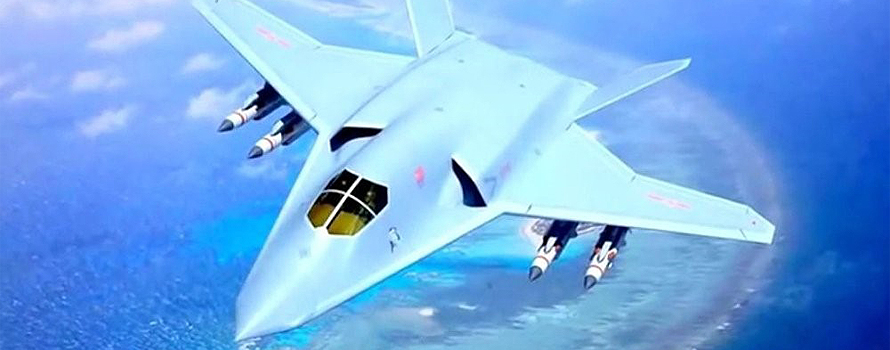
▲The H6K of the People's Liberation Army Air Force of China flying over the Pacific
COMMENTARY / Ignacio Cristóbal Urbicain* [Spanish version]
Only three countries in the world have strategic or long-range bombers (USA, Russia and China). The mission of this type of weapons is to project force over very long distances, normally within enemy airspace, in order to destroy, using its important armament load, strategic objectives, such as industry, infrastructure and logistics. It is also an important deterrent weapon.
In the case of China, its strategic aviation has the mission, required by the defense of its national interests, of projecting a threat at very long distances in order to avoid the approach and entry of the US Navy battle groups (aircraft carriers and cruise ships) into the South China Sea.
For this purpose, China has the Xian H-6. This aircraft is a derivation of the Russian Tupolev Tu-16 developed 60 years ago. In 2007 the Chinese modernized their H-6 by changing the old engines in order to reach a greater range (3,500 km). They chose Russian engines, although some sources say that a new Chinese engine (WS-18) is being developed. Likewise, a general electronic and air-ground radar modernization was carried out. Their ability to search for targets is unknown. The bomb bay was downsized to put inside another fuel tank; it was modified as well to house the 2,200 km range CJ-10th cruise missiles. In this way the H-6K was created, much more modern than the previous version, which maintains the possibility of carrying nuclear weapons, as well as the anti-ship supersonic missiles YJ-12.
A squad of 15 of these planes (this is the number of aircrafts that Jane's Defense thinks are in service) can shoot around a hundred missiles, creating an important problem for a naval group with bad intentions. We must notice that in recent weeks the H-6K have been seen for the first time with bombs on the external supports of the wings.
In December 2016, Chinese Ministry of Defense sources confirmed the rumors about the development of a new long-range bomber. This new project is likely to be a stealth aircraft (very low detectability to radar), with a long range ("second line of islands" –from central Japan to east of Indonesia, crossing over the island of Guam, USA-), as well as being able to load large amount of conventional weaponry in an internal weapons bay. The bomber will improve the capacity of the Chinese air force to circumvent enemy radars.
At the moment its name is H-X, although Jane's Defense already calls it H-20. Apparently the bomber will not be able to carry nuclear weapons, since China has a nuclear policy of "not attacking first", which means that it will not be the one who initiates a conflict with nuclear weapons. For all these reasons, China has a nuclear arsenal that follows the idea that the country would survive a first attack and will be able to strike back.
The task of the new bomber will be to keep any American carrier force, with its very well defended battle group, out of China's areas of interest. These aircraft, armed with long-range air-surface missiles, will be one of the three legs of Chinese deterrence. The other two are the attack submarines and the ballistic missiles.
Probably its design, commissioned to Xian Aircraft Corporation, is similar to the American B-2 Stealth Bomber, following the Chinese tradition of practically copying western models (the J-20 fighter is similar to the American F-22). Its first flight could take place in 2025. A different question is when it will be operative; probably it is something very far in time, considering the delays for the first flight of the J-20 and its full operation. Hence the modernization of the H-6 commented at the beginning of the article.
The fighters are very complex weapons systems and it is not enough for them to fly. They must do so with the characteristics for which they were designed. In this case, China historically has a great dependence on Russian engines. China's engines have not worked as expected. Not to mention the electronics, which it is a field the US still wins by far.
*Professor, School of Economics and Business, University of Navarra

▲The H6K of the Chinese People's Liberation Army Air Force, in flight over the Pacific
COMMENTARY / Ignacio Cristóbal Urbicain* [English version]
Only three countries in the world have strategic or long-range bombers (the US, Russia and China). The mission statement of this subject Weapons is to project the force at very long distances, usually within enemy airspace in order to destroy, with its significant armament load, strategic objectives, i.e. industry, infrastructure, logistics, etc. It is also an important deterrent.
In the case of China, its strategic aviation mainly has the latter mission statement with respect to the defence of their interests by projecting a threat to very distant distances, i.e. avoiding rapprochement and entrance of the U.S. Navy's battle groups (aircraft carriers and attack cruisers) to the South China Sea.
For this task, China has the Xian H-6. This aircraft is a derivation of the Russian Tupolev Tu-16 developed 60 years ago. In 2007, the Chinese modernized their H-6s by changing the old engines to reach a longer range (3,500 km). Again Russian engines were chosen, although there are sources who have said that a new Chinese engine (WS-18) is being developed. A general electronic modernization and the air-to-ground radar were also carried out. Their ability to pursue targets is unknown. The bomb bay was reduced to put another inner fuel tank and modified to house the Wayside Cross CJ-10 with a range of 2,200 km. In this way, the H-6K was created, much more modern than the previous version, which maintains the possibility of carrying nuclear weapons, as well as the YJ-12 supersonic anti-ship missiles.
A squadron of 15 of these aircraft (i.e., the issue that Jane's Defence thinks are in service) can fire around 100 missiles, creating a major problem for a number of people.group naval with bad intentions. Note also that in recent weeks the H-6Ks have been seen for the first time with bombs on the outer wing mounts.
The future
In December 2016, sources in the Chinese Ministry of Defense confirmed the rumors about the development of a new long-range bomber. This new project it's probably sneaky (very leave It can be used to ensure that it has been able to load a large amount of conventional weaponry in an internal hold, which will improve stealth against enemy radars.
The designation is currently H-X, although Jane's Defense already calls it H-20. It appears that the bomber will not have the capability to carry nuclear weapons, as China has a "no strike first" nuclear policy, meaning it will not be the one to start a conflict with nuclear weapons. For all these reasons, it has a nuclear arsenal linked to the idea that the country would survive a first attack and would be able torefund the coup.
The function of this new bomber will be to ensure that a force of American aircraft carriers with their group closer than it should to their areas of interest. These aircraft, carrying long-range air-to-surface missiles against such well-defended naval groupings, will be one of the three legs of Chinese deterrence. The other two are attack submarines and ballistic missiles.
Probably your design, commissioned to Xian Aircraft Corporation, is similar to the American B-2 bomber, following the Chinese tradition of practically copying Western models (the J-20 fighter is similar to the American F-22) and its first flight may be in 2025. Another question is when it will be operational, but seeing what the first flight of the J-20 has cost and its operability, it seems very distant in time. Hence the modernization of the H-6 discussed at the beginning of the article.
Fighter jets are very complex weapons systems and it is not enough for them to fly. They must do so with the characteristics for which they have been designed. In this case, China has historically been heavily dependent on Russian engines. Theirs have not worked as expected. Not to mention electronics, which in this field the U.S. still beats it by far.
*Teacher School of Economics and Business, University of Navarra
This crucial shipping lane faces hard power pressures from both states as they yearn for naval control of contested waters
A thermometer to measure the future balance of power between China and India will be the Strait of Malacca, the key bottleneck that connects the northern Indian Ocean and the Asia-Pacific region. India is advancing positions towards the western mouth of the Strait in order to challenge the expansion of Chinese maritime interests, which pay greater attention to Malacca.
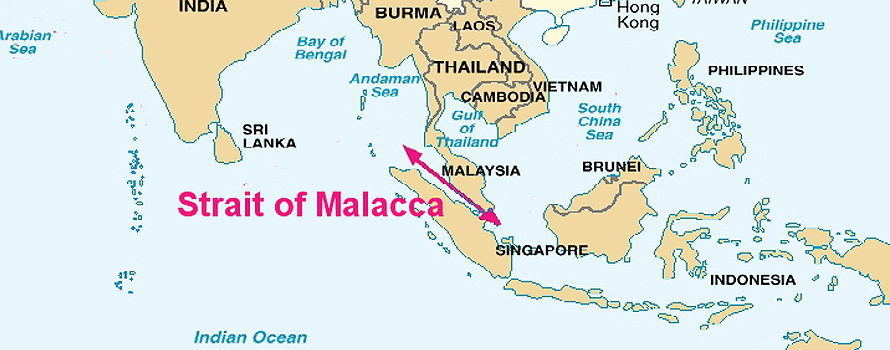
▲Map of the Indo-Pacific region [US DoD].
ARTICLE / Alejandro Puigrefagut [English version] [Spanish version].
Maritime routes are the basis of trade and communication between more than 80% of the countries of the world. This fact makes the natural geographic location of the States a great strategic feature. An especially important point for maritime traffic is the Strait of Malacca, key for trade in the region with the largest population on the planet.
The Strait of Malacca, which connects the South China Sea with the Burma Sea on its way to the Bay of Bengal, is the busiest commercial crossing in the world and, therefore, is a strategic place. Through this corridor that surrounds the western coast of the Malay peninsula and the Indonesian island of Sumatra, approximately 60% of the world's maritime trade transits, exceeding one hundred and fifty ships per day and is the main source of oil supply for two of the main Asian consumers; the People's Republic of China and Japan. This geographical point is key for the entire Indo Pacific region, thus ensuring the free movement of ships becomes strategic. That is why many States in the region, including China and the United States, see the need for protection of this passage in order to be able to supply themselves, export their merchandise and not be blocked by the control of a third country over this area.
In relation to China it is not easy to think that a blockade of its supply due to problems in the Strait of Malacca will happen. In order for this to happen, an armed conflict of great dimensions would have to be generated, propitiating this blockade by a subject that could control - and potentially interrupt - the passage towards the other countries of the region. This potential risk, which today can only be generated by the United States Navy, forces China to be alert and have to develop sufficient military capabilities to protect what it considers its territories in the South China Sea and, by extension, the supply of vital resources that must necessarily cross the Strait of Malacca.
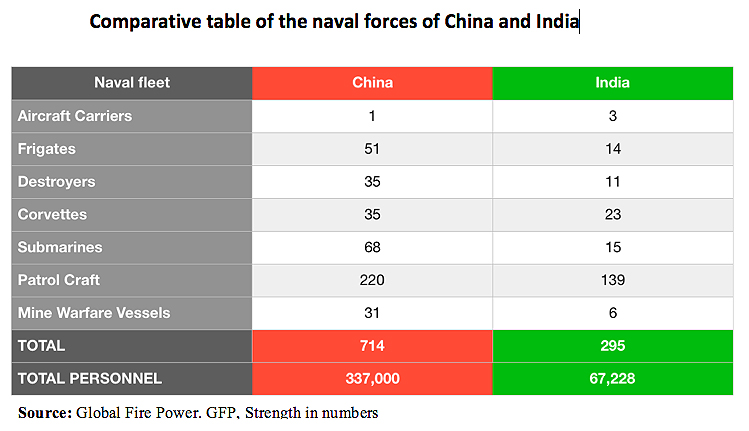 |
The positions and presence of the Asian giant in the South China Sea and in the areas adjacent to the Strait of Malacca have increased during the last years, in order to increase its influence on the States of the region. Moreover, to defend its oil and natural gas supplies (from the Persian Gulf), China has extended its presence to the Indian Ocean, although this is not enough. The reality is that in this area there is a great competition between two of the Asian powers with more influence in the region: China and India. Due to the increasing presence and influence of the People's Republic in the Indian Ocean, India has been forced to take proactive measures to improve peace and stability in the region, mobilizing and expanding its presence from its east coast towards the Strait, in order to rebalance the regional power. With this, India can dominate the western access to the Strait and, therefore, have a longer reaction time to maneuver in the Indian Ocean as in the Strait itself and, even, access to the waters of the South China Sea more agilely.
At the same time, this growing approximation of India to the South China Sea, is observed with concern in Beijing, and even, some analysts see India as a threat if an hypothetical case of a war between the two regional powers could occur and India were to block the Strait and, therefore, China's access to certain raw materials and other resources. For this reason, China has carried out various military maneuvers in the past three years together with third States in the Strait of Malacca, especially with Malaysia. During the first exercises in the area, the Ministry of Defence of the People's Republic of China concluded that bilateral relations with Malaysia were strengthened in terms of cooperation in security and defense and that "increase the capacity to jointly respond to real security threats and safeguard regional maritime security." In addition, for China, the protection of the Strait is a priority because of its great strategic value and because countries like the US or Japan also want to control it.
The well-trodden step, decisive in the strategies of both countries to counter each other
A thermometer to measure the future pulse of forces between China and India will be the Strait of Malacca, a passage through the Strait of Malay core topic for the connection between the northern Indian Ocean and the Asia-Pacific region. India is responding to the further expansion of Chinese maritime interests, which force Beijing to pay close attention to Malacca, by advancing positions towards the western mouth of the strait.

▲Map of the Indo-Pacific [US DoD]
article / Alejandro Puigrefagut [English version]
Sea routes are the basis of trade and communication between more than 80% of the world's countries. This fact makes the natural geographical location of States of great strategic importance. A particularly important point for maritime traffic is the Strait of Malacca. core topic for the trade of the most populous region on the planet.
The Strait of Malacca, which links the South China Sea with the Burma Sea on its way to the Bay of Bengal, is the world's busiest commercial passage and is therefore a strategic location. This corridor , which surrounds the western coast of the Malay Peninsula and the Indonesian island of Sumatra, is used by approximately 60% of the world's maritime trade, exceeding one hundred and fifty ships per day, and is the main oil supply route for two of Asia's main consumers: the People's Republic of China and Japan. This geographical point is core topic for the entire Indo-Pacific region, ensuring the free movement of ships is strategic. That is why many states in the region, including China and the United States, see the need to protect this passage in order to be able to supply themselves, export their goods and not be blocked by the control of a third country over this area.
In relation to China, it is not easy to think that a blockade of its supply due to problems in the Strait of Malacca will happen. For this to happen, an armed conflict of extraordinary dimensions would have to be generated, propitiating this blockade by a subject that could control – and potentially interrupt – the passage to the other countries of the region. This potential risk, which today can only be generated by the U.S. Navy, forces China to be vigilant and have to develop sufficient military capabilities to protect what it considers its territories in the South China Sea and, by extension, the supply of vital resources that must necessarily pass through the Strait of Malacca.
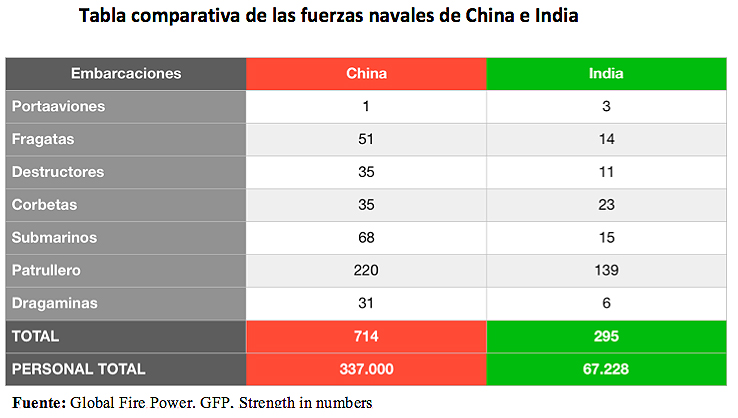 |
The Asian giant's positions and presence in the South China Sea and in the areas adjacent to the Strait of Malacca have increased in recent years, with the aim of increasing its influence over the states of the region. Moreover, in order to defend its supplies of oil and natural gas (from the Persian Gulf), China has extended its presence to the Indian Ocean, although this is not enough. The reality is that in this area there is a large skill between two of the most influential Asian powers in the region: China and India. Due to the growing presence and influence of the People's Republic in the Indian Ocean, India has been forced to take proactive measures to improve peace and stability in the region, mobilizing and expanding its presence from its east coast to the vicinity of the Strait, in order to rebalance the regional balance of power. In this way, India can dominate the western access to the Strait and, consequently, have a longer reaction time to manoeuvre in the Indian Ocean as well as in the Strait itself and even access the waters of the South China Sea more quickly.
At the same time, India's growing approach to the South China Sea is watched with concern in Beijing, and some analysts even see India as a threat in the hypothetical case of a war between the two regional powers and India blocks the Strait and, therefore, China's access to certain raw materials and other resources. For this reason, China has conducted a number of joint military exercises with third States in the Strait of Malacca over the past three years, especially with Malaysia. During the first exercises in the area, the Ministry of Defense of the People's Republic of China concluded that bilateral relations with Malaysia were strengthened in terms of security and defense cooperation and that the joint response capability to security threats was "increased." In addition, for China, the protection of the Strait is a priority because of its great strategic value and because countries such as the United States are a key factor in the protection of the Strait . The U.S. and Japan also want to control it.
[Admiral James Stavridis, Sea Power. The History and Geopolitics of the World's Oceans. Penguin Press. New York City, 2017. 363 pages]
REVIEW / Iñigo Bronte Barea [Spanish version].
In the era of globalization and its communication society, where everything is closer, and distances seem to vanish, the mass of water between the continents hasn't lost the strategic value it has always had. Historically, the seas have been as much a channel for human development as instruments of geopolitical dominance. It is no coincidence that the great world powers of the last 200 years have been great naval powers as well. We continue living the dispute over the maritime space at the present time and nothing suggests that the geopolitics of the seas will stop being crucial in the future.
Little have these principles changed on the importance of the maritime powers since they were expounded at the end of the 19th century by Alfred T. Mahan. Sea Power speaks of its validity today. The History and Geopolitics of the World's Oceans, by Admiral James G. Stavridis, retired in 2013 after having directed the U.S. Southern Command, the U.S. European Command and the supreme NATO leadership.
The book is the fruit of Mahan's early readings and a long career of almost four decades touring the seas and oceans with the US Navy. At the beginning of each explanation about the different marine spaces, Stavridis recounts his brief experience in that sea or ocean, to then continue with the history, and the development that they have had, until they reach their current context. Finally there is a projection about the near future that the world will have from the perspective of marine geopolitics.
Pacific: The emergence of China.
Admiral J. G. Stavridis begins his journey through the Pacific Ocean, which he categorizes as "the mother of all oceans" due to its immensity, since, by itself, it is larger than the entire combined planet's land surface. Another noteworthy point is that in its immensity there is no considerable land mass, although there are islands of all kinds, with very diverse cultures. That's why the sea dominates the geography of the Pacific as it does not anywhere else on the planet.
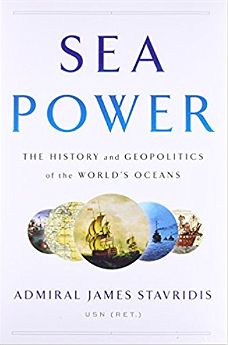 |
The great dominator of this marine space is Australia, which is very aware of what can happen politically in the archipelagos of nearby islands. However, it was the Europeans who explored the Pacific well (Magellan was the first, around 1500) and tried to connect it with their world in a way that was not merely transitory and commercial, but stable and lasting.
The United States began to be present in the Pacific since the acquisition of California (1840), but it was not until the annexation of Hawaii (1898) that the immense country was catapulted definitively towards the Pacific. The first time this ocean emerged as a zone of total war was in 1941 when Pearl Harbor was massacred by the Japanese. With the return of peace, the Japanese revival and the emergence of China, Taiwan, Korea, Singapore and Hong Kong made trans-Pacific trade surpass the Atlantic for the first time in the 1980s, and this trend continues. This is so, because the Pacific region contains the largest world powers on its coasts. In the geopolitical arena, a great arms race is taking place in the Pacific, with North Korea as a major source of tension and uncertainty worldwide.
Atlantic: from the Panama Canal to NATO
As for the Atlantic Ocean, Stavridis refers to it as the cradle of civilization, since the Mediterranean is included among its territories, and even more so if we consider it as the link between the people of all America and Africa with Europe. It has two great seas of great historical importance such as the Caribbean and the Mediterranean.
Undoubtedly the historical figure of this ocean is that of Christopher Columbus, since with his arrival in America (Bahamas 1492) began a new historical period that ended with virtually the entire American continent colonized by European powers in later centuries. While Portugal and Spain were concentrated in the Caribbean and South America, the British and the French did so in North America.
During the First World War, the Atlantic became an essential transit area for the development of the war, since, through it, the United States brought its troops, war materials and goods to Europe during the conflict. It was here that the idea of a community of the Atlantic countries that would eventually lead to the creation of NATO began to take shape.
Regarding the Caribbean, the author considers it as a region installed in the past. Its colonization was characterized by the arrival of slaves to exploit the natural resources of the region for purposes of economic interest for the Spanish. In addition, this process was characterized by the desire to convert the indigenous population to Christianity.
The Panama Canal is an engine for the economy of the region, but in Central America it is also possible to sail along the coasts of the countries with the highest rates of violence on the planet. Admiral Stavridis considers the Caribbean coast as a kind of Wild West that in some places has evolved little since the times of the pirates, and in which the drug cartels are currently operating with total impunity.
Since the 1820s, with the Monroe Doctrine, the United States carried out a series of interventions through its navy to reinforce regional stability and leave Europeans out of places such as Haiti, the Dominican Republic and Central America. In the 20th century, politics was dominated by caudillos, and communism and the Cold War soon reached the Caribbean, with Cuba as a zone zero.
Indian and Arctic: from the unknown to the risk
The Indian Ocean has less history and geopolitics than the other two great oceans. Despite this, its tributary seas have been gaining geopolitical importance in the post-World War II era with the increase in global navigation and the export of oil from the Gulf region. The Indian Ocean could be considered nowadays as a region to exercise smart power rather than hard power. While the slave trade and piracy has declined to almost disappear almost everywhere, they are still present in parts of the Indian Ocean. It's a region in which countries from the whole world could collaborate all together in order to fight against these common problems.
The history of Indian Ocean doesn't inspire confidence in the potential for peaceful governance in the years to come. An important key to unlock the potential of the region should be to solve the existing conflicts between India and Pakistan (threatening the use of nuclear weapons) and the Shia-Sunni division in the Arabian Gulf, which make the region very volatile. Due to the tensions of the Gulf countries, the region is today a kind of cold war between the Sunnis, led by Saudi Arabia, and the Shiites, led by Iran; the U.S., with its Fifth Fleet, is in the middle of these two sides.
Finally, the Arctic is currently a mystery. Stavridis considers that it is both a promise and a danger. Over the centuries, all oceans and seas have been the site of epic battles and discoveries, but there is one exception: the Arctic Ocean.
It seems clear that this exceptionality is coming to an end. The Arctic is an emerging maritime boundary with increasing human activity, rapidly melting ice blocks and important hydrocarbon resources that are beginning to be within reach. However, there are great risks that will dangerously condition the exploitation of this region, such as weather conditions, confused governance due to the confluence of five bordering countries (Russia, Norway, Canada, the United States and Denmark), and geopolitical competition between NATO and Russia, whose relations are deteriorating in recent years.
[Admiral James Stavridis, Sea Power. The History and Geopolitics of the World's Oceans. Penguin Press. New York City, 2017. 363 pages]
review / Iñigo Bronte Barea [English version].
In the era of globalisation and its communication society, where everything is closer and distances seem to fade away, the body of water between continents has not lost the strategic value it has always had. Historically, the seas have been both a channel for human development and instruments of geopolitical domination. It is no coincidence that the great world powers of the last 200 years have themselves been great naval powers. The dispute over maritime space is still going on today and there is nothing to suggest that the geopolitics of the seas will cease to be crucial in the future.
These principles on the importance of maritime powers have changed little since they were set out in the late 19th century by Alfred T. Mahan. Today, Sea Power. The History and Geopolitics of the World's Oceans, by Admiral James G. Stavridis, who retired in 2013 after leading the US Southern Command, the US European Command and the supreme command of NATO.
The book is the fruit of Mahan's early reading and an extensive degree program of nearly four decades on the seas and oceans with the US Navy. At the beginning of each explanation of the different sea spaces, Stavridis recounts his brief experience in that sea or ocean, then continues with the history, and the development they have had, until arriving at their current context. Finally, there is a projection of the near future of the world from the perspective of marine geopolitics.
Pacific: China's emergence
Admiral J.G. Stavridis begins his voyage in the Pacific Ocean, which he categorises as "the mother of all oceans" because of its immensity, since it alone is larger than the entire land surface of the planet combined. Another remarkable point is that in its vastness there is no considerable landmass, although there are islands all over the world subject, with very diverse cultures. This is why the sea dominates the geography of the Pacific like nowhere else on the planet.
 |
The great dominator of this marine space is Australia, which is very much aware of what might happen politically in the island archipelagos in its vicinity. It was Europeans, however, who explored the Pacific well (Magellan was the first, around 1500) and tried to connect it with their world in a way that was not merely transitory and commercial, but stable and lasting.
The United States began its presence in the Pacific with the acquisition of California (1840), but it was not until the annexation of Hawaii (1898) that the huge country was definitively catapulted into the Pacific. The first time this ocean emerged as a total war zone was in 1941 when Pearl Harbour was massacred by the Japanese.
With the return of peace, the Japanese revival and the emergence of China, Taiwan, Korea, Singapore and Hong Kong caused trans-Pacific trade to overtake the Atlantic for the first time in the 1980s, and this trend is still continuing. This is because the Pacific region contains the world's major powers on its shores.
degree program At area geopolitics a major arms race is taking place in the Pacific, with North Korea as a major focus of global tension and uncertainty.
Atlantic: from the Panama Canal to NATO
As for the Atlantic Ocean, Stavridis refers to it as the cradle of civilisation, since the Mediterranean is included among its territories, and even more so if we consider it as the nexus between the peoples of the Americas and Africa and Europe. It has two great seas of great historical importance, the Caribbean and the Mediterranean.
Undoubtedly the historical figure of this ocean is Christopher Columbus, since his arrival in America (Bahamas 1492) initiated a new historical period that ended with practically the entire American continent being colonised by the European powers in the following centuries. While Portugal and Spain concentrated on the Caribbean and South America, the British and the French concentrated on North America.
During the First World War, the Atlantic became an essential transit zone for the war development as the United States transported troops, war materials and goods to Europe during the conflict. It was here that the idea of an Atlantic community began to take shape, leading to the creation of NATO.
As for the Caribbean, the author sees it as a region that is rooted in the past. Its colonisation was characterised by the arrival of slaves to exploit the region's natural resources for purposes of economic interest to the Spanish. In turn, this process was characterised by the desire to convert the indigenous population to Christianity.
The Panama Canal is a driving force for the region's Economics , but Central America is also sailing along the coasts of the countries with the highest violence fees on the planet. Admiral Stavridis sees the Caribbean coast as a kind of Wild West, which in some places has evolved little since the days of pirates, and where drug cartels now operate with impunity.
Since the 1820s, with the Monroe Doctrine, the United States carried out a series of interventions through its navy to bolster regional stability and keep Europeans out of places such as Haiti, the Dominican Republic and Central America. In the 20th century, politics was dominated by caudillos, and soon communism and the Cold War came with them to the Caribbean, with Cuba as ground zero.
Indian Ocean and Arctic: from unknown to risky
The Indian Ocean has less history and geopolitics than the other two great oceans. Despite this, its tributary seas have gained geopolitical importance in the post-World War II era with the rise of global shipping and the export of oil from the Gulf region. The Indian Ocean today could be seen as a region for wielding smart power rather than hard power. While the slave trade and piracy have dwindled almost everywhere, they are still present in parts of the Indian Ocean. It is a region where countries around the world could work together to combat these common problems.
The history of the Indian Ocean does not inspire confidence about the potential for peaceful governance in the years to come. An important core topic to unlock the region's potential would be to resolve the existing conflicts between India and Pakistan (a conflict with the risk of nuclear weapons) and the Shia-Sunni divide in the Persian Gulf, issues that make it a very volatile region. Due to tensions in the Gulf countries, the region is today a kind of cold war between the Sunnis, led by Saudi Arabia, and the Shiites, led by Iran, and between these two sides, the United States, with its Fifth Fleet, is at the centre.
Finally, the Arctic is currently an unknown quantity. Stavridis sees it as both a promise and a danger. Over the centuries, all oceans and seas have been the site of epic battles and discoveries, but there is one exception: the Arctic Ocean.
It seems clear that this exceptionality is coming to an end. The Arctic is an emerging maritime frontier with increasing human activity, rapidly melting ice shelves and significant hydrocarbon resources coming within reach. However, there are major risks that will dangerously condition the exploitation of this region, such as weather conditions, unclear governance due to the confluence of five bordering countries (Russia, Norway, Canada, the United States and Denmark), and geopolitical competition between NATO and Russia, whose relations have deteriorated in recent years.
The neighbors of the United States in the Western Hemisphere find it difficult to interpret the first year of the new administration
Donald Trump reaches his first anniversary as president of the United States having caused some recent fires in Latin America. His rude disregard for El Salvador and Haiti, due to the high figures of refugees sheltered in the U.S., and his harsh treatment of Colombia, for the increase in cocaine production, had damaged relations. Although they were already complicated in the case of Mexico, throughout the year they had some good times, such as the presidents' dinner that Trump summoned in September in New York in which a united action was drawn on Venezuela.
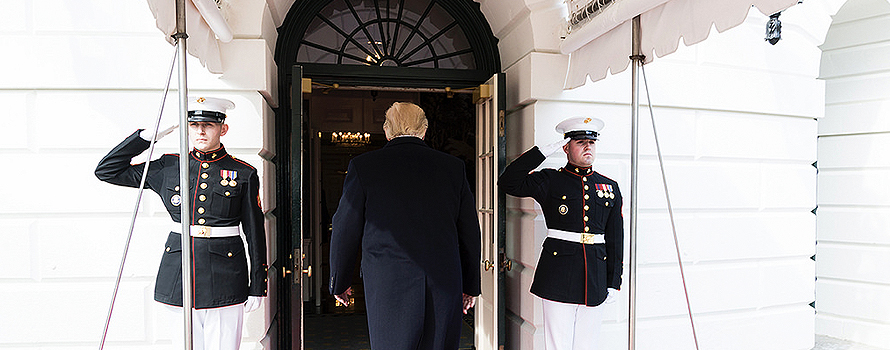
▲Trump in his first 100 days as president [White House].
ARTICLE / Garhem O. Padilla [English version] [Spanish version].
One year after the inauguration of the 45th President of the United States of America, Donald John Trump (the ceremony was on January 20), the controversy dominates the balance of the new administration, both in his domestic as well as international performance. The continental neighbors of the United States, in particular, show bewilderment about Trump's policies towards the hemisphere. On the one hand, they regret the American disinterest in commitments of economic development and multilateral integration; on the other hand, they note some activity in relation to some regional problems, such as the Venezuelan one. The actual balance is mixed, although there is unanimity that the language and many of Trump's forms threaten relationships.
From the TPP to NAFTA
In the economic field, the Trump era started with the definitive withdrawal of the United States from the Trans-Pacific Strategic Economic Partnership Agreement (TPP), on January 23, 2017. This made it impossible to enter into force since the United States is the market through which above all, this agreement emerged. The U.S. withdrawal affected the perspectives of the Latin American countries participating in the initiative.
Then, the renegotiation of the North American Free Trade Agreement (NAFTA), demanded by Trump, was opened. The doubts about the future of the NAFTA, signed in 1994 and that Trump has described as "disaster", have stood out in what is going of the administration. Some of its demands, which Mexico and Canada oppose, are to increase the share of products manufactured in the United States, and the "sunset" clause, which would force the treaty to be reviewed methodically every five years and suspend it if any of its three members did not agree. All this, arises from the idea of the U.S. president to suspend the treaty if it is not favorable for his country.
Cuba and Venezuela
If the quarrels with Mexico have not yet reached to an end, in the case of Cuba, Trump has already retaliated against the Castro regime, with the expulsion in October of 15 Cuban diplomats from the Cuban Embassy in Washington in response to"the sonic attacks" that affected 24 U.S. diplomats on the island. The White House, in addition, has revoked some conciliatory measures of the Obama administration because the Castro regime is not responding with open-ended concessions.
As far as Venezuela is concerned, Trump has made strong efforts in terms of introducing measures and sanctions against corrupt officials, in addition to addressing the political situation with other countries, so that they support those efforts aimed at eradicating the Venezuelan crisis, thus generating multilateralism between American countries. However, this policy has detractors, who believe that the sanctions are not intended to achieve a long-term objective, and it is not clear how they would promote Venezuelan stability.
Although in those actions on Cuba and Venezuela Trump has alluded to the democratic principles violated by the governors of Havana and Caracas, his administration has not insisted especially on the commitment to human rights, democracy and moral values, as being usual in the argumentation of the U.S. foreign policy. Some critics point out that the Trump administration is willing to promote human rights only when they meet its political objectives.
This could explain the worsening of the opinion that exists in Latin America about the United States and about the relations with that country. According to the Latinobarómetro survey 2017, the favorable opinion has fallen to 67%, seven points below that at the end of the Obama administration, which was 74%. This survey shows a significant difference for Mexico, one of the countries that, without a doubt, has the worst levels of favorable opinion towards the Trump administration: in 2017 it was 48%, which means a fall of 29 points in comparison with 2016, in which it was 77%.
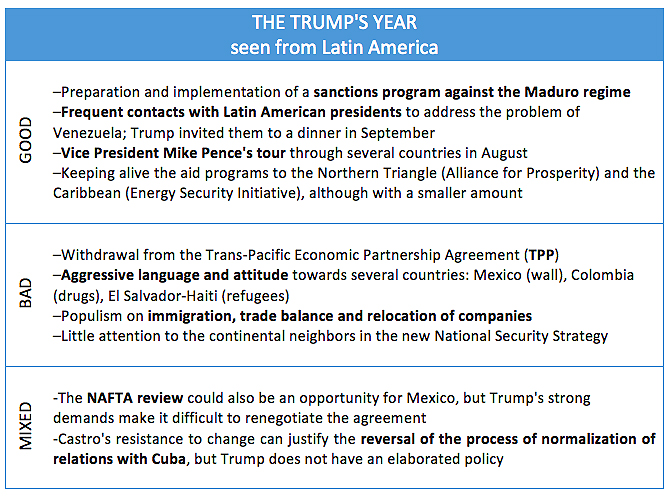 |
Immigration, withdrawal, decline
The restrictive immigration policies applied would also explain that rejection of the Trump administration by Latin American public opinion. In the immigration section the most recent is the decision not to renew the authorization to stay in the United States of thousands of Salvadorans and Haitians, who once entered the U.S. fleeing calamities in their countries.
We must also allude to Trump's efforts to achieve one of its main objectives since the beginning of his political campaign: to build a border wall with Mexico. The U.S. president has not had much success at this time, since although he has looked for ways to finance it, what he has managed to introduce in the budgets is very insignificant in relation to the estimated costs.
Trump's protectionism entails a withdrawal that may be accentuating the decline of the U.S. leadership in Latin America, especially against other powers. China has been increasing its economic and political performance in countries such as Argentina, Brazil, Chile, Peru and Venezuela. Russia, for its part, has strengthened diplomatic and security relations with Cuba. It could be said that, taking advantage of the conflicts between Cuba and the United States, Moscow has tried to keep the island in its orbit through a series of investments.
Threats to security
This leads us to mention the new National Security Strategy of the United States, announced in December. The document presented by Trump addresses the rivalry with China and Russia, and also refers to the challenge posed by the regimes of Cuba and Venezuela, by the supposed threats to security they represent and the support of Russia they receive. Trump expressed great desire to see Cuba and Venezuela join "shared freedom and prosperity" and called for "isolating governments that refuse to act as responsible partners in advancing hemispheric peace and prosperity."
Similarly, the new U.S. Security Strategy refers to other challenges in the region, such as transnational criminal organizations, which impede the stability of Central American countries, especially Honduras, Guatemala and El Salvador. All in all, the document only dedicates one page to Latin America, in line with Washington's traditional attention given to the areas of the world that most affect their interests and security.
An opportunity for the United States to approach the Latin American countries will be the Summit of the Americas, which will be held next March in Lima. However, nothing is predictable given the characteristic attitude of the president, which leaves a large open space for possible surprises.
Continental U.S. neighbors are having a hard time interpreting the first year of the new Administration.
Donald Trump arrives at his first anniversary as president having set some recent fires in Latin America. His rude disregard for El Salvador and Haiti, due to the volume of refugees welcomed in the United States, and his intemperate attention to Colombia for the increase in cocaine production worsen relations that, although already complicated in the case of Mexico, have had some good moments throughout the year, such as the dinner of presidents that Trump convened in September in New York in which a united action on Venezuela was outlined.

▲Trump, on completing 100 days as president [White House].
article / Garhem O. Padilla [English version].
One year after the arrival of the 45th President of the United States of America, Donald John Trump, to the White House -the inauguration ceremony was on January 20-, controversy dominates the balance of the new Administration, both in its domestic and international performance. The continental neighbors of the U.S., in particular, show bewilderment over Trump's policies toward the hemisphere. On the one hand, they regret the U.S. disinterest in commitments to economicdevelopment and multilateral integration; on the other, they note some activity in relation to some regional problems, such as Venezuela. The balance for the moment is mixed, although there is unanimous agreement that Trump's language and many of his manners rather threaten relations.
From TPP to NAFTA
agreement In the economic field, the Trump era began with the withdrawal final of the United States from the Trans-Pacific Partnership (TPP) on January 23, 2017. This made it impossible for entrance to enter into force, as the United States is the market for which the TPP was created agreement, which has affected the prospects of the Latin American countries that participated in the initiative.
The renegotiation of the North American Free Trade Agreement (NAFTA), demanded by Trump, was immediately opened. Doubts about the future of NAFTA, signed in 1994 and which Trump has described as a "disaster", have been prominent so far in his administration. Some of his demands, which Mexico and Canada oppose, are to increase the quota for products manufactured in the United States and the "sunset" clause, which would oblige the treaty to be reviewed methodically every five years and would cause it to be suspended if any of its three members were not in agreement with agreement. All of this stems from the U.S. president's idea of fail the treaty if it is not favorable to his country.
Cuba and Venezuela
If the quarrels with Mexico have not yet reached a conclusion, in the case of Cuba Trump has already retaliated against the Castro regime, with the expulsion in October of 15 Cuban diplomats from the Cuban embassy in Washington as a response to the "sonic attacks" that affected 24 U.S. diplomats on the island. The White House has also reversed some of the Obama Administration's conciliatory measures, when it realized that Castroism is not responding with openness concessions.
As far as Venezuela is concerned, Trump has made forceful efforts to introduce measures and sanctions against corrupt officials, in addition to addressing the political status with other countries, so that they support those efforts aimed at eradicating the Venezuelan crisis, thus generating multilateralism among American countries. However, this policy has its detractors, who believe that the sanctions are not intended to achieve a long-term goal deadline , and it is unclear how they would promote Venezuelan stability.
Although in these actions on Cuba and Venezuela Trump has alluded to the democratic principles violated by the rulers of Havana and Caracas, his Administration has not particularly insisted on the commitment to human rights, democracy and moral values, as had been usual in the argumentation of U.S. foreign policy. Some critics point out that the Trump Administration is willing to promote human rights only when they fit its political objectives.
This could explain the worsening opinion in Latin America about the United States and relations with that country. From agreement with the survey Latinobarómetro 2017, the favorable opinion has fallen to 67%, seven points below the one at the end of the Obama Administration, which was 74%. Said survey sample a relevant difference for Mexico, one of the countries that, without a doubt, has the worst levels of favorable opinion towards the Trump Administration: in 2017 it was 48%, a drop of 29 points compared to 2016, when it was 77%.
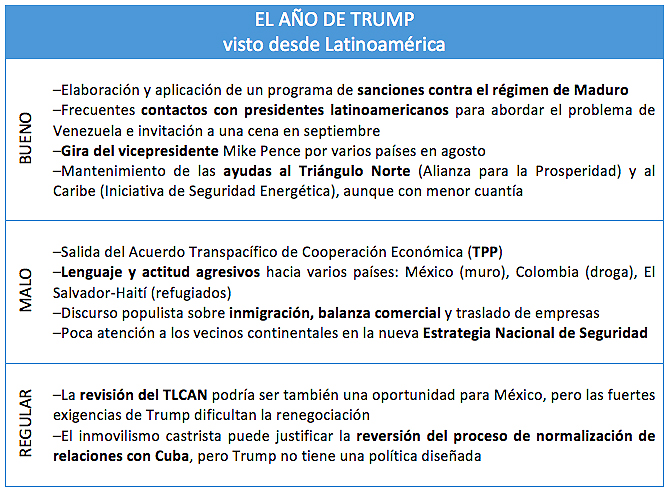 |
Immigration, withdrawal, decline
The restrictive immigration policies applied would also explain the rejection of the Trump Administration by Latin American public opinion. In the immigration section the most recent is the decision not to renew the authorization to stay in the United States of thousands of Salvadorans and Haitians, who once arrived fleeing calamities in their countries.
It is also worth mentioning Trump's efforts to achieve one of his main objectives since the beginning of his political campaign: to build a border wall with Mexico. The U.S. president has not been very successful so far in this goal, since despite having sought ways to finance it, what he has managed to introduce in the budgets is very insignificant in relation to the estimated costs. On the other hand, his decision
Trump's protectionism entails a retreat that may be accentuating the decline of the United States as a leader in Latin America, especially vis-à-vis other powers. China has been increasing its economic and political engagement in countries such as Argentina, Brazil, Chile, Peru and Venezuela. Russia, for its part, has strengthened its diplomatic and security relations with Cuba. It could be said that, taking advantage of the conflicts between the island and the United States, Moscow has sought to keep it in its orbit through a series of investments.
Security threats
This leads us to mention the new US National Security Strategy, announced in December. The document, presented by Trump, addresses the rivalry with China and Russia, and also refers to challenge the Cuban and Venezuelan regimes, for the alleged security threats they pose and the Russian support they receive. Trump expressed a strong desire to see Cuba and Venezuela join in "shared freedom and prosperity" and called to "isolate governments that refuse to act as responsible partners in advancing hemispheric peace and prosperity."
Similarly, the new U.S. Security Strategy alludes to other challenges in the region, such as transnational criminal organizations, which impede the stability of Central American countries, especially Honduras, Guatemala and El Salvador. However, the document devotes only one page to Latin America, in line with Washington's traditional focus on the areas of the world that most affect its interests and security.
An opportunity for the United States to get closer to Latin American countries will be the Summit of the Americas, to be held next March in Lima. However, nothing is predictable given the President's characteristic attitude, which leaves a great deal of room for possible surprises.
[Graham Allison, Destined for War. Can America and China Escape Thucydides's Trap? Houghton Mifflin Harcourt. Boston, 2017. 364 pages]
REVIEW / Emili J. Blasco [Spanish version]
This is what has been called the Thucydides Trap: the dilemma facing a hegemonic power and a rising one that threatens that hegemony. Is war inevitable? When Thucydides recounted the Peloponnesian War, he wrote about the inevitability for the dominant Sparta and the emerging Athens to think of armed confrontation as a means of settling the conflict.
The fact that these two Greek polis necessarily thought about war –and finally they waged it–, does not mean that they did not have other options. History has shown that there are other alternatives: when Wilhemine Germany threatened to overcome Britain's naval force, the attempt of sorpasso (accompanied by several circumstances) led to the First World War, but when Portugal was overtaken by Spain in overseas possessions in the sixteenth century, or when the United States replaced Britain as the world's leading power in the late nineteenth century the power transfer was peaceful.
Destined for War. Can America and China Escape Thucydides's Trap?, by Graham Allison, is a call to Washington and Beijing to do everything possible to avoid falling into the trap described by the Greek historian. In this book, the founding dean of the Harvard Kennedy School of Government reviews several historical precedents. Harvard's Belfer Center for Science and International Affairs, of which Allison is director, has researched on them in a program called precisely Thucydides's Trap.
This concept is defined by Allison as "the severe structural stress caused when a rising power threatens to upend a ruling one. In such condition, not just extraordinary, unexpected events, but even ordinary flashpoints of foreign affairs, can trigger large-scale conflict."
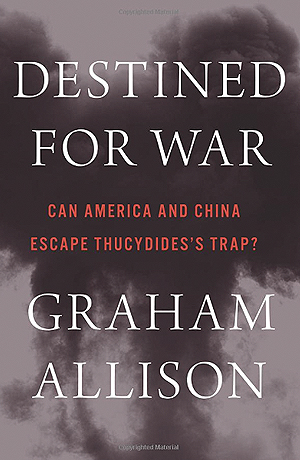 |
The structural stress is produced by the clash of two deep sensibilities: the rising power syndrome ("a rising state's enhanced sense of itself, its interests, and its entitlement to recognition and respect"), and its mirror image, the ruling power syndrome ("the established power exhibiting an enlarged sense of fear and insecurity as it faces intimations of decline").
Along with those syndroms, the two rival powers also experience a 'secutity dilemma': "A rising power may discount a ruling state's fear and insecurity because it 'knows' itself to be well-meaning. Meanwhile, its opponent misunderstands even positive initiatives as overly demanding, or even threatening."
The use of military force
Allison starts from the fact that China is already putting itself on par with the United States as a world power. It has done so in terms of the volume of its economy (China has already overtaken the U.S. in Purchasing Power Parity) and with regard to some aspects of military force (a report by Rand Corporation predicted that in 2017 China would have an "advantage" or "approximate parity" in 6 of the 9 areas of conventional capability). The author's assumption is that China will soon be able to wrest from the United States the scepter of main superpower. In this situation, how will both countries react?
In the case of China, its thousand-year perspective will probably lead to an attitude of patience, provided there is at least some small progress in its purpose of increasing its global weight. Since 1949 China has only resorted to force in three of 33 territorial disputes. In those cases, the Chinese leaders waged the war –they were limited wars, conceived as a warning to their opponents– even though the enemy was equal or greater, urged by a situation of domestic unrest.
For Allison, "As long as developments in the South China Sea are generally moving in China's favor, it appears unlikely to use military force. But if trends in the correlation of forces should shift against it, particularly at a moment of domestic political instability, China would initiate a limited military conflict, even against a larger, more powerful state like the US."
For its part, the United States can choose several strategies, according to Allison: accommodate to the new reality, undermine Chinese power (commercial war, fostering separatism of the provinces), negotiate a long peace, and redefine the relationship. The author does not give firm advice, but seems to suggest that Washington should move between the last two options.
He recalls how Britain understood that it could not compete with the United States in the Western Hemisphere, and how from there a collaboration between the two countries grew, as manifested in the First and Second World War. This should happen by accepting that the South China Sea is an area of Chinese influence. The United States should admit this, not out of mere condescension, but because it proceeds to a real clarification of its vital interests.
Despite its positive tone, Destined for War is one of the essays by the American establishment where the end of the American era and the passing the baton to China are most openly announced (it does not seem to glimpse a multipolar or bipolar world, but rather a primacy of the Asian country). It is also one of those assays that puts less accent –clearly less than it should– on the remaining strengths of the U.S. and the problems that can undermine the coronation of China.
